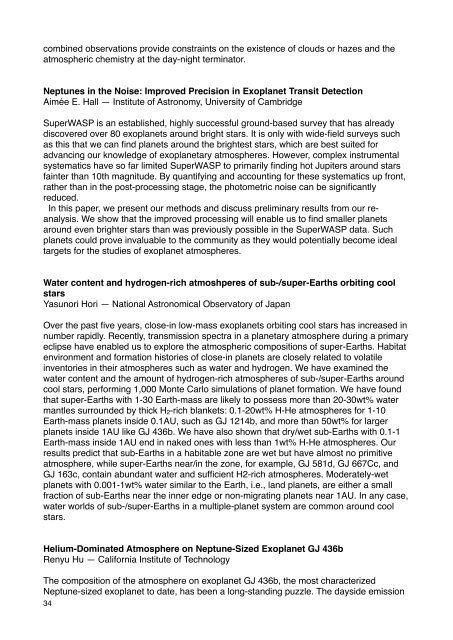Exoclimes_Conference_booklet1
Exoclimes_Conference_booklet1
Exoclimes_Conference_booklet1
You also want an ePaper? Increase the reach of your titles
YUMPU automatically turns print PDFs into web optimized ePapers that Google loves.
combined observations provide constraints on the existence of clouds or hazes and the<br />
atmospheric chemistry at the day-night terminator.<br />
Neptunes in the Noise: Improved Precision in Exoplanet Transit Detection!<br />
Aimée E. Hall — Institute of Astronomy, University of Cambridge!<br />
SuperWASP is an established, highly successful ground-based survey that has already<br />
discovered over 80 exoplanets around bright stars. It is only with wide-field surveys such<br />
as this that we can find planets around the brightest stars, which are best suited for<br />
advancing our knowledge of exoplanetary atmospheres. However, complex instrumental<br />
systematics have so far limited SuperWASP to primarily finding hot Jupiters around stars<br />
fainter than 10th magnitude. By quantifying and accounting for these systematics up front,<br />
rather than in the post-processing stage, the photometric noise can be significantly<br />
reduced.<br />
In this paper, we present our methods and discuss preliminary results from our reanalysis.<br />
We show that the improved processing will enable us to find smaller planets<br />
around even brighter stars than was previously possible in the SuperWASP data. Such<br />
planets could prove invaluable to the community as they would potentially become ideal<br />
targets for the studies of exoplanet atmospheres.<br />
Water content and hydrogen-rich atmoshperes of sub-/super-Earths orbiting cool<br />
stars<br />
Yasunori Hori — National Astronomical Observatory of Japan!<br />
Over the past five years, close-in low-mass exoplanets orbiting cool stars has increased in<br />
number rapidly. Recently, transmission spectra in a planetary atmosphere during a primary<br />
eclipse have enabled us to explore the atmospheric compositions of super-Earths. Habitat<br />
environment and formation histories of close-in planets are closely related to volatile<br />
inventories in their atmospheres such as water and hydrogen. We have examined the<br />
water content and the amount of hydrogen-rich atmospheres of sub-/super-Earths around<br />
cool stars, performing 1,000 Monte Carlo simulations of planet formation. We have found<br />
that super-Earths with 1-30 Earth-mass are likely to possess more than 20-30wt% water<br />
mantles surrounded by thick H2-rich blankets: 0.1-20wt% H-He atmospheres for 1-10<br />
Earth-mass planets inside 0.1AU, such as GJ 1214b, and more than 50wt% for larger<br />
planets inside 1AU like GJ 436b. We have also shown that dry/wet sub-Earths with 0.1-1<br />
Earth-mass inside 1AU end in naked ones with less than 1wt% H-He atmospheres. Our<br />
results predict that sub-Earths in a habitable zone are wet but have almost no primitive<br />
atmosphere, while super-Earths near/in the zone, for example, GJ 581d, GJ 667Cc, and<br />
GJ 163c, contain abundant water and sufficient H2-rich atmospheres. Moderately-wet<br />
planets with 0.001-1wt% water similar to the Earth, i.e., land planets, are either a small<br />
fraction of sub-Earths near the inner edge or non-migrating planets near 1AU. In any case,<br />
water worlds of sub-/super-Earths in a multiple-planet system are common around cool<br />
stars.<br />
Helium-Dominated Atmosphere on Neptune-Sized Exoplanet GJ 436b<br />
Renyu Hu — California Institute of Technology!<br />
The composition of the atmosphere on exoplanet GJ 436b, the most characterized<br />
Neptune-sized exoplanet to date, has been a long-standing puzzle. The dayside emission<br />
34


